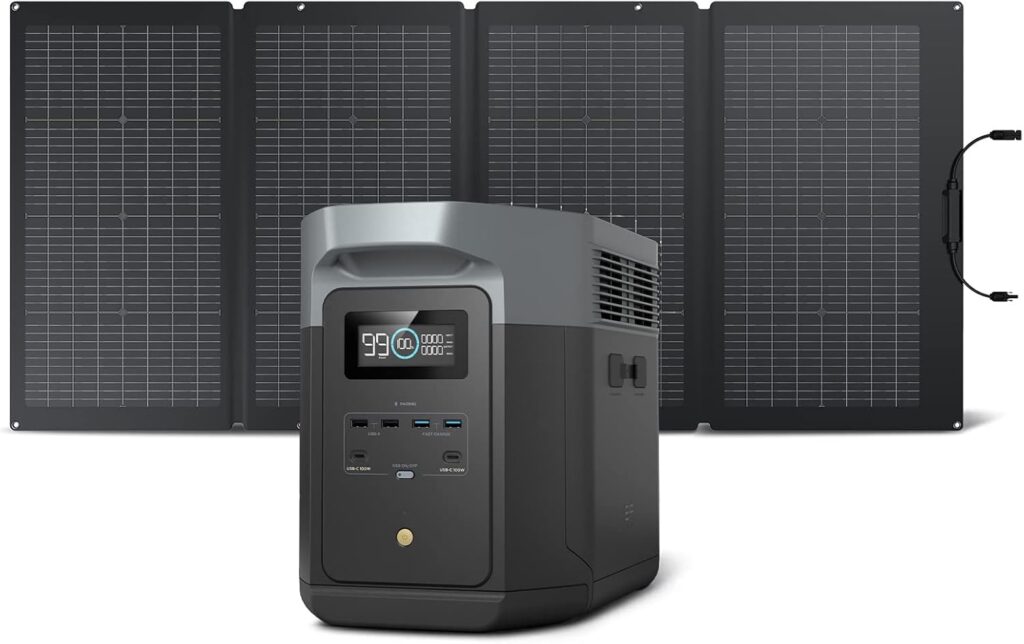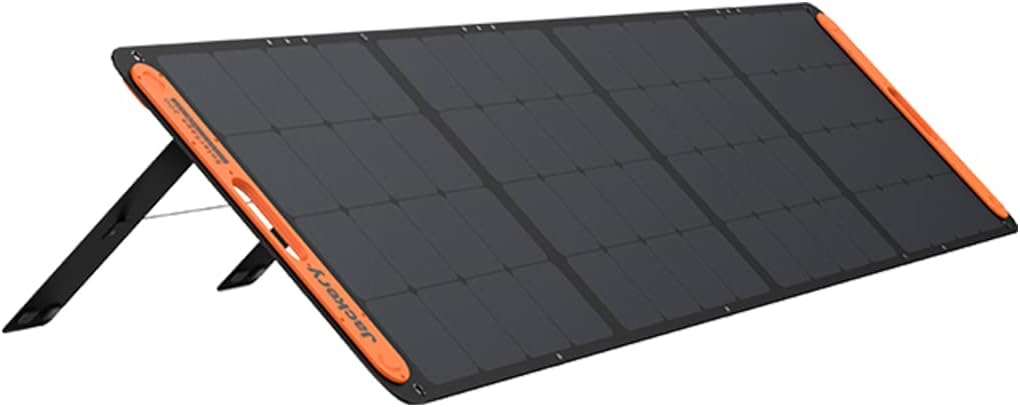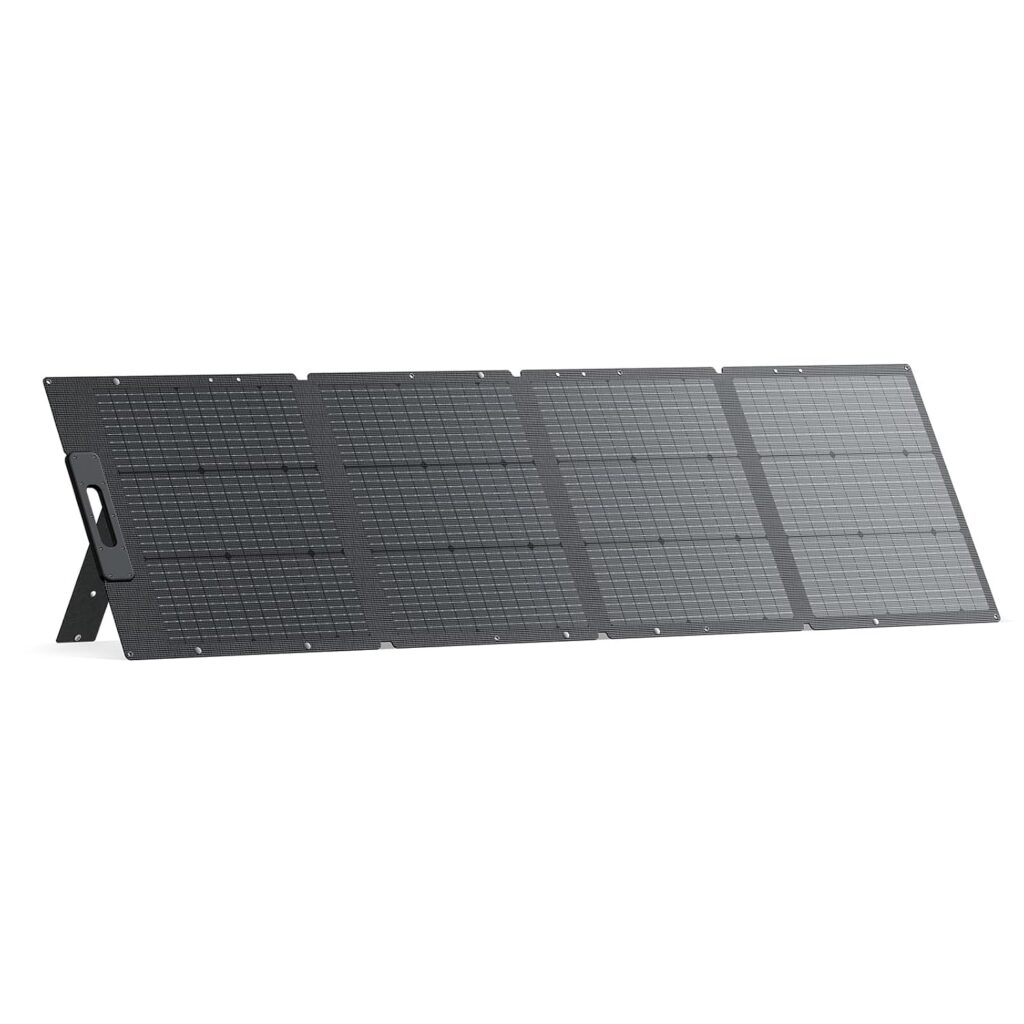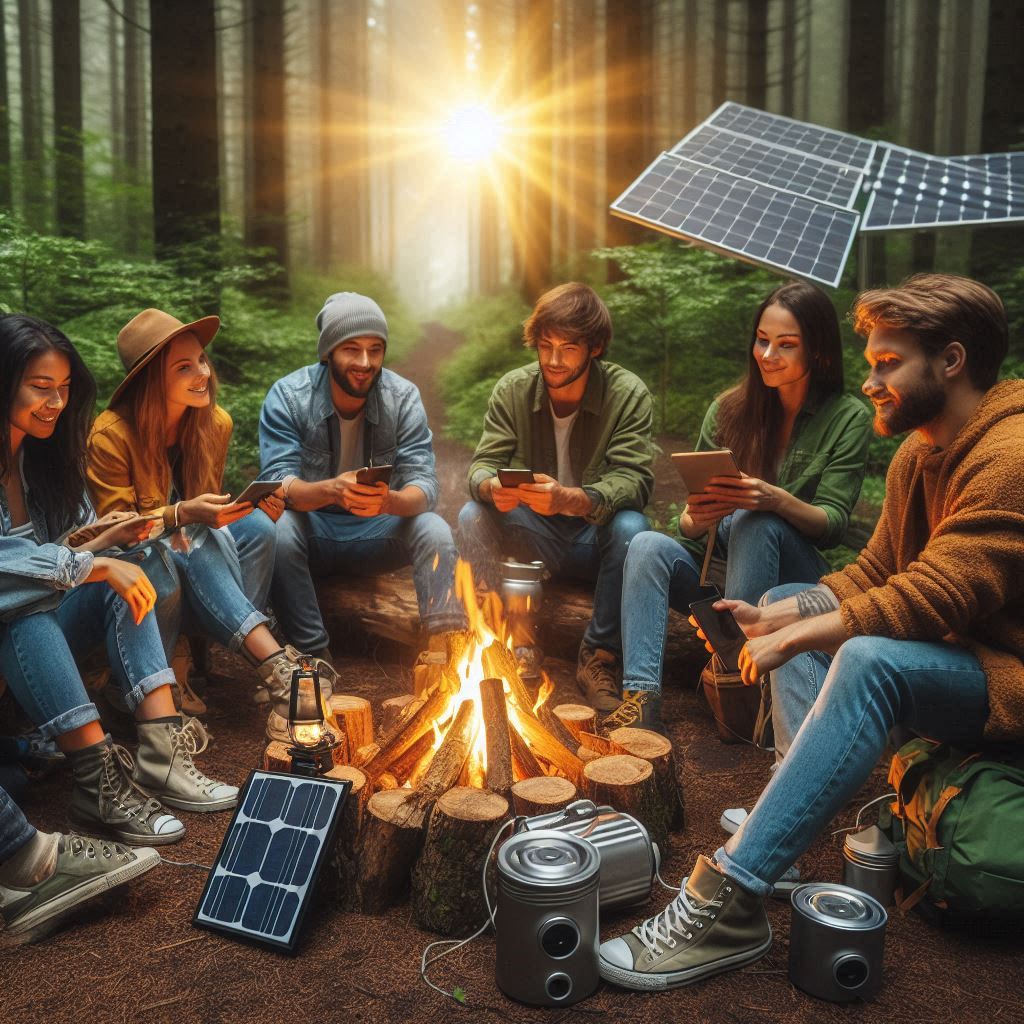10 Best Portable Solar Panels for Camping (2025)
Looking for the best portable solar panels for camping to keep your devices powered during outdoor adventures? Our comprehensive guide compares the top lightweight, durable, and high-efficiency solar chargers of 2025, helping you make an informed decision based on your specific camping power needs.
Table of Contents
Affiliate Disclosure: In the interest of transparency, I must inform you that I earn commission from qualifying purchases without any cost to you. If you would like to read full disclosure, please click here.
What Are Portable Solar Panels for Camping?

Portable solar panels for camping are lightweight, compact devices designed to harness solar energy and convert it into usable electricity while you’re off the grid. Unlike traditional solar installations, these panels are specifically engineered for mobility and outdoor use, making them perfect companions for camping trips, RV adventures, and other outdoor activities.
How Do Portable Solar Panels Work?
Portable solar panels work by using photovoltaic cells (typically made from monocrystalline or polycrystalline silicon) to convert sunlight into electricity. When sunlight hits these cells, it knocks electrons loose, creating an electric current that can be captured and used to charge devices or stored in a battery for later use.
Most camping solar panels include these key components:
- Solar cells (monocrystalline or polycrystalline)
- Protective casing or frame
- Charge controller to regulate power output
- Output connections (USB ports, MC4 connectors, etc.)
- Foldable design or kickstand for optimal positioning
Types of Portable Solar Panels for Camping
Foldable Solar Panels
These panels fold up like a briefcase for easy transport and storage. They’re typically lightweight and come with built-in kickstands for optimal positioning toward the sun. Foldable panels are ideal for campers who need a balance of portability and power.
Rigid Solar Panels
More durable but less portable, rigid panels offer higher efficiency and longevity. They’re better suited for semi-permanent setups like RVs or base camps where they won’t need to be moved frequently.
Flexible Solar Panels
Ultra-lightweight and bendable up to 30 degrees, these panels can conform to curved surfaces like tent roofs or backpacks. They sacrifice some efficiency for extreme portability, making them ideal for backpackers and hikers.
Solar Blankets
These ultra-thin, fabric-based solar collectors can be draped over tents or hung from trees. They’re incredibly lightweight but typically offer lower wattage than other options.
Buying Guide: How to Choose the Right Portable Solar Panel

Selecting the best portable solar panel for camping requires considering several key factors that will impact performance, convenience, and value. Here’s what to look for when making your decision:
Power Output (Wattage)
The wattage of a solar panel determines how much power it can generate under ideal conditions. Higher wattage means faster charging but also typically means larger panels and higher cost.
| Your Needs | Recommended Wattage | Typical Devices |
| Basic | 20-60W | Smartphones, tablets, small batteries |
| Moderate | 100-120W | Laptops, DSLR cameras, portable power stations |
| High | 200-400W | Multiple devices, small appliances, larger power stations |
Panel Efficiency
Efficiency refers to how effectively a panel converts sunlight into electricity. Higher efficiency panels generate more power from the same surface area, making them more effective in limited space or low-light conditions.
Monocrystalline Panels
Efficiency: 20-23%
Recognizable by their uniform black color, monocrystalline panels offer the highest efficiency and perform better in low-light conditions. They’re more expensive but provide better performance per square inch.
Polycrystalline Panels
Efficiency: 15-17%
With their distinctive blue, marbled appearance, polycrystalline panels are more affordable but less efficient. They require more surface area to generate the same power as monocrystalline panels.
Portability and Weight
For camping, especially if you’ll be hiking to your destination, weight and packed size are crucial considerations.
- Ultralight (1-5 lbs): Ideal for backpacking and hiking
- Lightweight (5-10 lbs): Good balance for most camping scenarios
- Standard (10-20 lbs): Better for car camping or RV use
- Heavy (20+ lbs): Best for semi-permanent setups
Durability and Weather Resistance
Camping environments can be harsh, so look for panels with:
- Water resistance (IP65 rating or higher)
- Durable frames or protective cases
- Scratch-resistant surfaces
- Temperature tolerance (-10°C to 65°C is ideal)
Connectivity Options
Consider how you’ll connect your devices to the solar panel:
- USB Ports: Direct charging for small devices
- MC4 Connectors: Standard for connecting to power stations
- DC Output: For connecting to certain batteries or devices
- Anderson/SAE/XT60 Connectors: For specific power stations or batteries
Not Sure What You Need?
Check out our comprehensive guide on calculating your camping power requirements to determine the perfect solar setup for your specific needs.Calculate Your Power Needs
Top 10 Portable Solar Panels for Camping in 2025
After testing dozens of models and analyzing hundreds of user reviews, we’ve identified the best portable solar panels for camping across various categories. Here are our top picks for 2025:

1. AFERIY Portable Power Station 3600W with 400W Portable Solar Panel – Best Overall

AFERIY Portable Power Station 3600Wh with 2*400W Portable Solar Panel
The AFERIY 3600W system stands out as our top overall pick for 2025, offering an exceptional balance of power, portability, and versatility for camping enthusiasts. With its impressive 3600W output and efficient 400W solar panel, this combination can power everything from small electronics to larger camping appliances.
Pros
- High 3600Wh output handles most camping appliances
- 2 Efficient 400W solar panel for faster charging
- Multiple output options (AC, USB, DC)
- Foldable design with carrying case
- Excellent build quality and weather resistance
Cons
- Premium price point
- Heavier than some alternatives
- Requires significant sun exposure for full charging
Overall Rating 4.8
Power Output 4.8/5
Portability 4.3/5
Durability 4.7/5
Value for Money 4.4/5
2. ECOFLOW DELTA 2 Max Solar Generator – Best Budget Option

ECOFLOW DELTA 2 Max Solar Generator
For campers seeking a more affordable yet capable solar solution, the ECOFLOW DELTA 2 Max offers impressive performance at a budget-friendly price point. This compact system provides reliable power for essential camping gear and devices without breaking the bank.
Pros
- Excellent value for money
- User-friendly interface
- Fast charging capability
- Expandable with additional solar panels
- Compact and portable design
Cons
- Lower wattage than premium options
- Fewer output ports than some competitors
- Solar panel sold separately in some packages
Overall Rating 4.6
Power Output 4.3/5
Portability 4.6/5
Durability 4.5/5
Value for Money 4.9/5
3. Jackery SolarSaga 200W Portable Solar Panel – Best Premium Option

Jackery SolarSaga 200W Portable Solar Panel
The Jackery SolarSaga 200W represents the premium end of portable solar panels for camping, offering exceptional efficiency and build quality. This high-performance panel is perfect for serious campers who need reliable power in all conditions and are willing to invest in quality.
Pros
- High 200W output from a single panel
- Superior 23.7% conversion efficiency
- Excellent performance in low-light conditions
- Durable, weather-resistant construction (IP67)
- Folds to compact size with integrated handle
Cons
- Higher price point
- Heavier than lower-wattage options (18.3 lbs)
- Works best with Jackery power stations
Overall Rating 4.9
Power Output 4.9/5
Portability 4.2/5
Durability 4.9/5
Value for Money 4.4/5
4. BLUETTI PV200 200W Portable Solar Panel – Best for Durability

BLUETTI 200W Portable Solar Panel
The BLUETTI PV200 stands out for its exceptional durability and reliability in harsh outdoor conditions. Built to withstand the rigors of serious camping and outdoor adventures, this 200W panel offers a perfect combination of ruggedness and high performance.
Pros
- Military-grade durability with ETFE coating
- IP65 water and dust resistance
- High 23.4% conversion efficiency
- Excellent temperature tolerance (-4°F to 149°F)
- Stable kickstand for various terrain
Cons
- Slightly heavier than competitors (16.5 lbs)
- Higher price point
- Limited compatibility with non-BLUETTI power stations
Overall Rating 4.7
Power Output 4.7/5
Portability 4.1/5
Durability 5.0/5
Value for Money 4.3/5
5. Anker SOLIX PS200 Solar Panel with Adjustable Kickstand – (Best for Portability)

Anker SOLIX PS200 Solar Panel
For campers who prioritize portability without sacrificing too much power, the Anker 625 offers an excellent balance. At just 5.4 pounds, this 100W panel is one of the lightest in its class, making it ideal for backpackers and hikers who need reliable solar power on the go.
Pros
- Ultra-lightweight design (5.4 lbs)
- Compact folded size (20.7 × 14.3 × 1.9 inches)
- Built-in USB-A and USB-C ports
- Adjustable kickstand for optimal positioning
- IPX4 water resistance
Cons
- Lower wattage than larger options
- Less durable than heavier panels
- Performance drops in partial shade
Overall Rating 4.5
Power Output 4.0/5
Portability 4.9/5
Durability 4.2/5
Value for Money 4.5/5
Compare All Top Models
Want to see how all our recommended portable solar panels stack up against each other? Check out our comprehensive comparison table to find the perfect match for your camping needs.
Comparison of Top Portable Solar Panels for Camping
| Model | Wattage | Weight | Efficiency | Weather Rating | Best For | Price Range |
| AFERIY 2048Wh | 3600 | 41kg | 23% | IP67 | Overall Performance | $$$ |
| ECOFLOW DELTA 2 Max | 2448Wh | 9.5kg | 23% | IP67 | Budget Option | $$ |
| Jackery SolarSaga 200W | 200W | 10.8kg | 24.3% | IP67 | Premium Quality | $$$ |
| BLUETTI PV200 | 200W | 9.07kg | 23.4% | IP65 | Durability | $$$ |
| Anker SOLIX PS200 | 200W | 9.23kg | 23% | IP67 | Portability | $$ |
How to Use Portable Solar Panels Effectively While Camping

Getting the most from your portable solar panels requires proper setup and positioning. Follow these tips to maximize your solar charging efficiency during your camping trips:
Optimal Positioning for Maximum Power
- Face the panel directly toward the sun – In the Northern Hemisphere, point panels south; in the Southern Hemisphere, point them north.
- Adjust the angle – Position your panel perpendicular to the sun’s rays (typically 30-45 degrees in summer, 45-60 degrees in winter).
- Reposition throughout the day – For maximum efficiency, adjust your panel’s position every 2-3 hours to follow the sun’s path.
- Avoid shade completely – Even partial shading can significantly reduce output (up to 80% in some cases).
- Use a solar angle guide – Some panels include this tool to help you find the optimal angle.
Connecting to Devices and Power Stations
Most portable solar panels don’t store energy themselves—they generate it for immediate use or storage in a battery or power station. Here’s how to connect your panel effectively:
Direct Device Charging
If your panel has built-in USB ports, you can charge small devices directly. This works best for:
- Smartphones and tablets
- Headlamps and small LED lights
- GPS devices and cameras
- Small power banks
Power Station Charging
For larger devices or to store energy for later, connect your panel to a portable power station:
- Use the appropriate connector (MC4, XT60, etc.)
- Check compatibility between your panel and power station
- Consider voltage and amperage limitations
- Use extension cables if needed for optimal panel placement
Maximizing Charging Efficiency
- Start early – Begin charging as soon as there’s good sunlight, typically from 9 AM to 3 PM for optimal results.
- Keep panels clean – Regularly wipe off dust, dirt, and debris that can block sunlight.
- Monitor temperature – Solar panels actually perform worse when too hot (above 77°F/25°C); provide airflow underneath if possible.
- Use a charge controller – This prevents overcharging and optimizes power flow to your battery.
- Consider multiple panels – For higher power needs, connect multiple panels in parallel or series (depending on your setup).
Pro Tip: Weather Considerations
Solar panels still work on cloudy days, but at reduced efficiency (typically 10-25% of rated output). During partly cloudy conditions, position your panel where it will receive the most consistent sunlight throughout the day rather than chasing small patches of sun.
Maintenance and Care Tips for Portable Solar Panels

Proper maintenance of your portable solar panels ensures optimal performance and extends their lifespan. Here are essential care tips for keeping your camping solar panels in top condition:
Cleaning Your Solar Panels
- Regular cleaning – Wipe down panels after each camping trip, especially if used in dusty or sandy environments.
- Use the right materials – Clean with a soft, non-abrasive cloth or sponge and mild soap diluted in water.
- Avoid harsh chemicals – Never use abrasive cleaners, solvents, or rough materials that could scratch the panel surface.
- Remove stubborn dirt – For bird droppings or tree sap, let soapy water sit for a few minutes before gently wiping.
- Dry thoroughly – After cleaning, dry panels completely with a soft cloth to prevent water spots.
Storage Best Practices
Proper storage between camping trips helps prevent damage and degradation of your solar panels:
- Store in a cool, dry place – Avoid extreme temperatures and humidity.
- Use protective cases – Most portable panels come with cases; use them to prevent scratches and damage.
- Clean before storing – Ensure panels are clean and completely dry before packing away.
- Avoid pressure on panels – Don’t place heavy objects on top of stored panels.
- Organize cables and connectors – Keep all accessories neatly stored with the panel to prevent tangling or loss.
Protecting Your Investment
Preventing Physical Damage
- Use caution when setting up on rocky terrain
- Secure panels during windy conditions
- Keep away from campfires and cooking areas
- Handle connectors and cables carefully
Preventing Theft
- Never leave panels unattended in public areas
- Use security cables or locks when appropriate
- Pack away panels when not in use
- Consider motion-activated alarms for extended setups
Important Safety Note
Never fold or store your solar panels when wet. This can lead to mold growth and potential damage to the electrical components. Always ensure panels are completely dry before folding and storing.
Frequently Asked Questions About Portable Solar Panels for Camping
How many watts do I need for camping?
The wattage you need depends on what you plan to power. For basic needs (charging phones, tablets, and small devices), a 60-100W panel is usually sufficient. For powering laptops, DSLR cameras, or small appliances, consider 100-200W. For running multiple devices or larger appliances, you’ll want 200W or more, potentially with multiple panels. Remember that actual power generation will be less than the rated wattage due to factors like cloud cover, panel angle, and time of day.
Do I need a battery with my portable solar panel?
In most cases, yes. Solar panels generate electricity only when exposed to sunlight, so a battery or power station is necessary to store energy for use when the sun isn’t shining (at night or during cloudy periods). Some small panels with built-in USB ports can charge devices directly, but for consistent power throughout your camping trip, a battery storage solution is essential. Popular options include portable power stations like those from Jackery, EcoFlow, or BLUETTI, which include built-in battery storage and inverters.
Can portable solar panels work in cloudy weather?
Yes, portable solar panels can still generate electricity in cloudy weather, but at significantly reduced efficiency. Typically, you can expect 10-25% of the rated output during overcast conditions. Modern monocrystalline panels perform better in low-light conditions than older technologies. To maximize output on cloudy days, ensure your panel is positioned optimally and consider using a solar panel with higher efficiency ratings (22%+) and MPPT charge controllers, which can better handle variable light conditions.
Are portable solar panels waterproof?
Most quality portable solar panels designed for camping have some level of water resistance, but the degree varies by model. Look for panels with IP ratings (such as IP65, IP67) which indicate protection against water and dust. While many can withstand light rain or morning dew, few are completely waterproof for extended submersion. Always check the manufacturer’s specifications and, as a precaution, try to protect your panels during heavy rainfall and never leave them in standing water. Also, ensure connections and junction boxes are properly sealed.
How long do portable solar panels last?
Quality portable solar panels typically last 5-10 years with proper care, though the photovoltaic cells themselves can function for 25+ years with gradually decreasing efficiency. The limiting factors for portable panels are usually the physical components like hinges, connectors, and protective coverings, which endure more wear and tear than fixed installations. Monocrystalline panels generally last longer than polycrystalline or thin-film options. Regular maintenance, proper storage, and protection from extreme conditions will significantly extend the lifespan of your portable solar panels.
Final Thoughts: Choosing the Best Portable Solar Panel for Your Camping Adventures
Selecting the best portable solar panel for camping comes down to balancing your specific power needs, budget, and camping style. Whether you’re a weekend warrior who needs basic device charging or a serious off-grid enthusiast requiring substantial power, there’s a portable solar solution that’s right for you.
For most campers, we recommend the AFERIY 3600W with 400W Portable Solar Panel as our top overall pick, offering an excellent balance of power, durability, and features. Budget-conscious campers will appreciate the ECOFLOW DELTA 2 Max, while those seeking premium performance should consider the Jackery SolarSaga 200W.
Remember that proper positioning, regular maintenance, and realistic expectations about power generation will help you get the most from whichever portable solar panel you choose. With the right solar setup, you can enjoy the comforts of electricity while embracing the freedom of off-grid camping.
Ready to Power Your Next Adventure?
Check out our top recommended portable solar panel for the perfect balance of power, portability, and durability.View Our Top Pick on Amazon
Kaleem,
www.greenlifehub.com.

